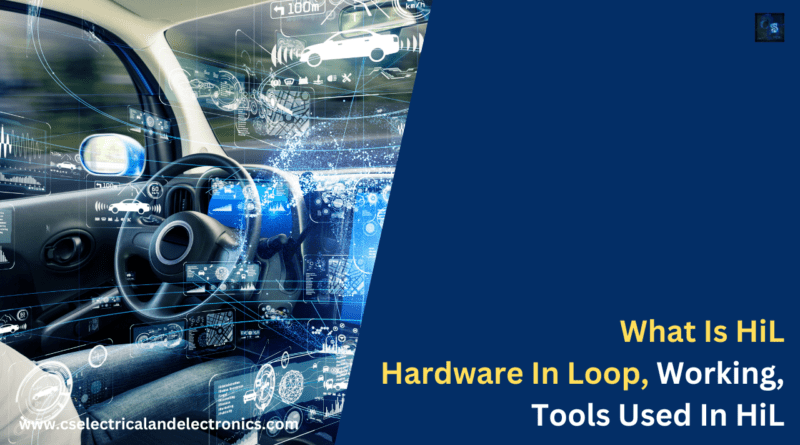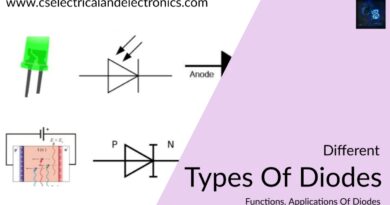What Is HiL, Hardware In Loop, Working, Tools Used In HiL
Hello Guys, welcome back to our blog. Here in this article, we will discuss what is HiL, Hardware In Loop testing in the Automotive Industry, working of HiL testing, what is the purpose of HiL testing in the Automotive Industry, and the types of tools used to perform HiL testing.
If you have any electrical, electronics, and computer science doubts, then ask questions. You can also catch me on Instagram – CS Electrical & Electronics.
Also, read:
- 100 (AI) Artificial Intelligence Applications In The Automotive Industry
- Top 10 High Paying Electrical And Electronics Jobs In 2023, 2024
- Top 200+ MATLAB Simulink Interview Questions With Answers
What Is HiL, Hardware In Loop
Hardware-in-the-loop (HiL) testing represents a sophisticated method widely utilized across diverse industries, especially in the automotive, aerospace, and industrial automation sectors. This particular technique has been engineered to authenticate and validate the performance of intricate systems by amalgamating tangible hardware elements within a simulated atmosphere. Its foundational premise revolves around the integration of physical constituents, like controllers or electronic control units (ECUs), into a simulated environment that mirrors real-world conditions.
During HiL testing, a specialized testing arrangement or configuration is established, encompassing genuine hardware components interfaced intricately with a simulation environment. This configuration facilitates the execution of comprehensive tests that replicate authentic operational situations, ensuring the hardware operates as anticipated before actual deployment. The simulated environment possesses the capability to imitate an extensive array of scenarios, encompassing environmental variables, diverse load conditions, and simulations of faults that might prove arduous or hazardous to reproduce directly in real-world testing.
One of the pivotal advantages attributed to HiL testing lies in its capacity to furnish a regulated and repeatable environment, empowering engineers to conduct thorough evaluations of hardware performance and behavior without solely relying on costly and time-consuming physical prototypes. The early detection of issues in the developmental phase through HiL testing significantly mitigates the risks associated with discovering faults or inefficiencies in later stages, thereby culminating in the establishment of more dependable and efficient systems.
Collectively, Hardware-in-the-loop testing assumes a pivotal role in the development and validation processes of complex systems, offering a cost-efficient and effective methodology to assure the reliability, safety, and functionality of hardware components across diverse industries.
Working of HiL Testing or Hardware In Loop Testing
Hardware-in-the-loop (HiL) testing, a technique pivotal in the development and validation of complex systems, finds extensive application across industries such as automotive, aerospace, and industrial automation. Its essence lies in subjecting a system or its components to scrutiny within a simulated or regulated environment, closely mirroring real-world conditions by amalgamating genuine hardware components with simulated counterparts.
Here’s a breakdown of its functioning:
01. Components:
- Real Hardware: Constituting the physical elements or subsystems of the system under examination.
- Simulated Environment: Software models simulate the behavior of system components, interacting with the genuine hardware.
02. Integration:
- Connecting the real hardware component being tested with the simulation environment.
- The simulation environment can emulate diverse scenarios and stimuli encountered during real-world operations.
03. Testing:
- Interaction between the real hardware and the simulated environment.
- Feeding inputs from the simulated environment to the hardware being scrutinized.
- Observing and analyzing the hardware’s responses to these inputs.
04. Benefits:
- Early Testing: Facilitating the assessment of components or systems before their full development or integration into the entire system.
- Cost Efficiency: Diminishing the necessity for physical prototypes and enabling extensive testing in a controlled setting.
- Safety: Permitting the testing of hazardous scenarios without jeopardizing actual hardware.
05. Applications:
- Automotive Industry: Testing electronic control units (ECUs), sensors, and actuators in vehicles.
- Aerospace: Validating avionics systems, flight control systems, etc.
- Industrial Automation: Scrutinizing controllers, sensors, and actuators in manufacturing systems.
Example Scenario:
In the automotive domain, HiL testing could involve linking a genuine electronic control unit (ECU) of an engine to a simulation environment replicating various driving conditions. This environment could simulate temperature fluctuations, load variations, or changes in road conditions. The ECU would respond to these simulated inputs as it would in a real vehicle.
Challenges:
- Fidelity: Ensuring the simulation environment accurately mirrors real-world conditions.
- Complexity: Confronting the challenge of integrating numerous hardware components and software simulations.
- Validation: Verifying that the outcomes obtained in the simulated environment reflect real-world behavior accurately.
- HiL testing stands as a potent instrument in the development and validation of complex systems, allowing for stringent testing, early issue identification, and refinement before the construction or deployment of physical prototypes.
Types of Tools used for HiL (Hardware-in Loop) Testing
PROVEtech: TA
A test automation tool for HiL, SiL, and MiL testing is called PROVEtech: TA. It is a feature-rich program that may be used to automate a large number of different test scenarios.
PROVEtech: TA is an effective solution for test automation because of the following features:
- Because it is database-driven, managing test cases and outcomes is made simple.
- Test case kinds that are supported by it include functional, performance, and safety tests.
- A graphical user interface, a script editor, and a data-driven test case generator are just a few of the tools it offers for managing and generating test cases.
- It is compatible with multiple target platforms, including as test benches, ECUs, and real-time simulators.
Numerous businesses in the automotive, aerospace, and industrial automation sectors employ PROVEtech: TA. Businesses that need to automate their testing procedures to increase productivity and cut expenses will find it to be a useful tool.
01. Real-time Simulators
a. dSPACE Simulink Real-Time: A well-liked real-time simulator for simulating a range of car systems, including the powertrain, chassis, and ADAS, is dSPACE Simulink Real-Time.
b. NI VeriStand: Another well-liked real-time simulator is NI VeriStand, which combines well with other NI tools and is renowned for being user-friendly.
c. MathWorks Simscape: A physics-based real-time simulator called MathWorks Simscape can be used to simulate intricate systems like suspension and powertrains.
02. I/O Hardware
a. I/O cards from National Instruments and dSPACE: A range of connections are offered by these cards to allow actual hardware to be connected to the real-time simulator.
b. OPAL-RT I/O cards: These cards are renowned for their great performance and extensive protocol support.
c. NI PXI Express I/O modules: These modules offer an expandable and modular method of implementing I/O hardware.
This was about “”. I hope this article may help you all a lot. Thank you for reading.
Also, read:
- 10 Tips To Maintain Battery For Long Life, Battery Maintainance
- 10 Tips To Save Electricity Bills, Save Money By Saving Electricity
- 100 (AI) Artificial Intelligence Applications In The Automotive Industry
- 100 + Electrical Engineering Projects For Students, Engineers
- 1000+ Control System Quiz, Top MCQ On Control System
- 1000+ Electrical Machines Quiz, Top MCQs On Electrical Machines
- 1000+ Electronics Projects For Engineers, Diploma, MTech Students
- 1000+ MATLAB Simulink Projects For MTech, Engineering Students
Author Profile
- Chetu
- Interest's ~ Engineering | Entrepreneurship | Politics | History | Travelling | Content Writing | Technology | Cooking
Latest entries
 All PostsApril 19, 2024What Is Vector CANoe Tool, Why It Is Used In The Automotive Industry
All PostsApril 19, 2024What Is Vector CANoe Tool, Why It Is Used In The Automotive Industry All PostsApril 13, 2024What Is TCM, Transmission Control Module, Working, Purpose,
All PostsApril 13, 2024What Is TCM, Transmission Control Module, Working, Purpose, All PostsApril 12, 2024Top 100 HiL hardware in loop Interview Questions With Answers For Engineers
All PostsApril 12, 2024Top 100 HiL hardware in loop Interview Questions With Answers For Engineers All PostsMarch 22, 2024Driver Monitoring Systems In Vehicles, Working, Driver Sleepy Alert
All PostsMarch 22, 2024Driver Monitoring Systems In Vehicles, Working, Driver Sleepy Alert








